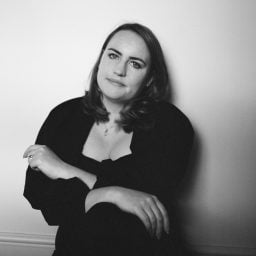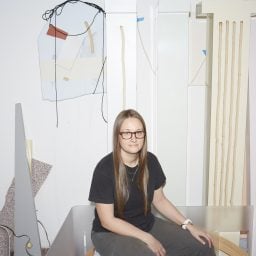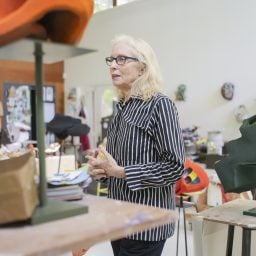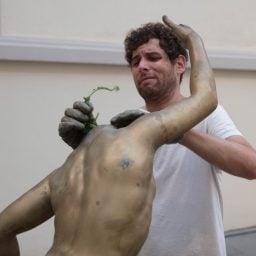Lockdown has been a restless time for the Zimbabwean artist Portia Zvavahera.
As an artist who draws inspiration from dreams and introspection, peace and quiet are essential to her process. The rising star’s ethereal work is filled with transcendent imagery that allows the viewer to peek beyond the veil of earthly existence. But amid the chaotic noise of the wider world this year, Zvavahera was struck by creative paralysis.
In search of inspiration, she fled her studio in Harare to seek refuge in the mountains and found herself able to pick up a brush after turning to prayer and reconnecting with the natural world. The resulting paintings are the subject of a show opening at David Zwirner in London on September 15. “Portia Zvavahera: Ndakavata pasi ndikamutswa nekuti anonditsigira” (a Shona title which translates to, “I took my rest in sleep and then I awoke for He sustained me”) includes five large-scale paintings.
We spoke to the artist about her ideal conditions for creativity and why she refuses to plan.
What are the most indispensable items in your studio and why?
I often have floral designs in my paintings, but recently I’ve been more inspired by the colors and shapes of coral reefs. To achieve these on the canvas, I use beeswax for batik and for color separation. I use the wax as a stencil, so I need that, and cardboard, to print.
Is there a picture you can send of your work in progress?
![Portia Zvavahera, <i>This is where I travelled [4]</i> ©Portia Zvavahera. Courtesy the artist, Stevenson, Cape Town and Johannesburg, and David Zwirner.](https://news.artnet.com/app/news-upload/2020/08/ZVAPO0001_CROP-822x1024.jpg)
Portia Zvavahera, This is where I travelled [4] ©Portia Zvavahera. Courtesy the artist, Stevenson, Cape Town and Johannesburg, and David Zwirner.
Sometimes when we sleep, we don’t know where we are going or where we are traveling to. During this time [of lockdown], my mother had a dream of people hanging me from a tree. She shouted at those people to cut me loose, but they took her in my place. When I was doing this painting, she fell and broke her knee. I became scared of finishing it. I thought the figures in the painting wanted to kill her, so I stopped painting it. But then I came up with a solution. I wanted to finish this painting, but to do that, I had to raise her up in another work. Instead of just having her on the ground, as if she were dying, I had to paint something that said “arise.” You can be strong beyond hurt. So I painted her salvation to give her healing in life. Here, you can see both works.
![Portia Zvavahera, This is where I travelled [5] ©Portia Zvavahera. Courtesy the artist, Stevenson, Cape Town and Johannesburg, and David Zwirner.](https://news.artnet.com/app/news-upload/2020/08/ZVAPO0003_CROP-886x1024.jpg)
Portia Zvavahera, This is where I travelled [5] ©Portia Zvavahera. Courtesy the artist, Stevenson, Cape Town and Johannesburg, and David Zwirner.
When I wake up, I go to the studio and wait for something to come. I don’t plan things. When I try to plan, I come into the studio and the complete opposite of what I intended happens.
What kind of atmosphere do you prefer when you work? Do you listen to music or podcasts, or do you prefer silence?
I just want to be completely alone and silent to bring out what I have inside me.
What trait do you most admire in a work of art? What trait do you most despise?
I love to see color, and different combinations of color. Even on a personal level, color helps me express myself more than anything else. It is color that makes things beautiful. When I go into my garden, what I take from there and bring into the painting is color and design. This is what I look for in artworks. What I don’t really like is when a work of art is explained to me. I love to look at a painting and communicate automatically with it.
What could your studio not function without?
My studio could not function without prayer. I love praying in the studio. I become more spiritual in the studio.
Who are your favorite artists, curators, or other thinkers to follow on social media right now?
I don’t really follow many people in terms of social media. I don’t want to be inspired by the works of other artists. I appreciate other people’s work, but I don’t want to accidentally “appropriate” something from someone else. Normally when I work, I avoid looking at other artworks. I go deeper into scripture and my dreams.
When you feel stuck in the studio, what do you do to get un-stuck?
This show was meant to take place around May or June but I didn’t have anything. I felt stuck. And so we went to a place in the mountains of Zimbabwe, Nyanga. There, I found time to be on my own, to pray. I’d lost track of my dreams, and who I really am, so when I went there, I was able to read the Bible, pray, and be inspired by nature and the flowers. I started dreaming again.
What is the last exhibition you saw (virtual or otherwise) that made an impression on you?
It was Kiki Smith’s exhibition at Monnaie de Paris in 2019. I like the way she works with sculpture—it was inspiring to see sculptures lying down in a museum. It is my wish to fill a museum with works.
If you had to put together a mood board, what would be on it right now?
I would place myself in a coral reef or in a garden, inside the coral and the flowers.
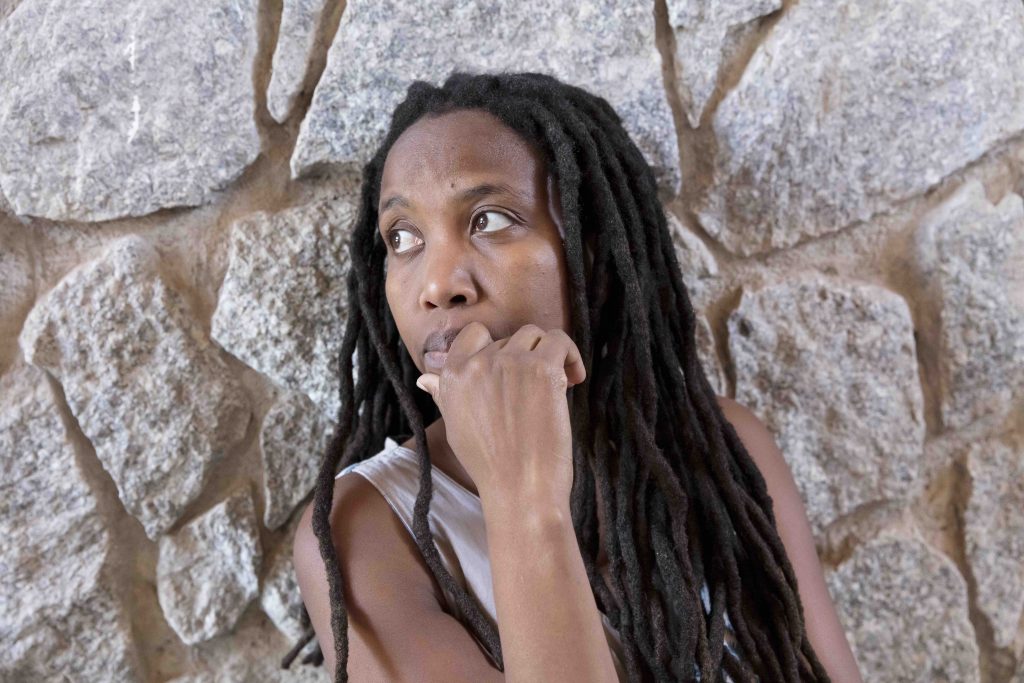

![Portia Zvavahera, <i>This is where I travelled [4]</i> ©Portia Zvavahera. Courtesy the artist, Stevenson, Cape Town and Johannesburg, and David Zwirner.](https://news.artnet.com/app/news-upload/2020/08/ZVAPO0001_CROP-822x1024.jpg)
![Portia Zvavahera, This is where I travelled [5] ©Portia Zvavahera. Courtesy the artist, Stevenson, Cape Town and Johannesburg, and David Zwirner.](https://news.artnet.com/app/news-upload/2020/08/ZVAPO0003_CROP-886x1024.jpg)
